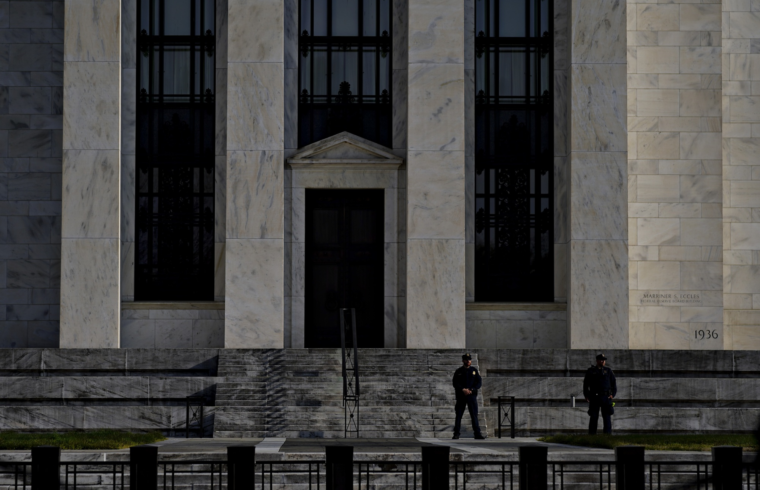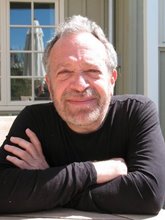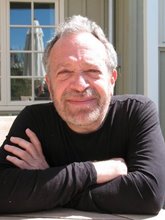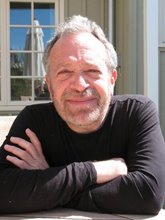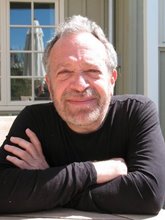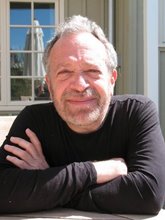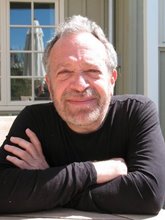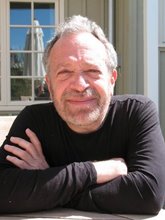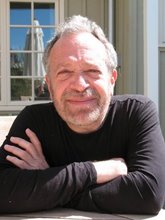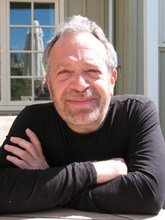Federal Reserve police officers stand outside the Marriner S. Eccles building in Washington, D.C. Photographer: Andrew Harrer/Bloomberg
Photographer: Andrew Harrer/Bloomberg
Federal Reserve officials are in no hurry to move interest rates up or down — and an escalation in the U.S.-China trade war could keep them on hold even longer.
Investors see a rate cut by the end of the year, but minutes of the Fed’s last policy meeting released Wednesday showed officials expect patience on rates to be appropriate for “some time.” They also raised their growth outlooks and sided with Chairman Jerome Powell that recent softness in prices was temporary.
“They were very careful to exclude any potential for a rate cut,’’ said Tom Simons, a senior economist at Jefferies LLC in New York. That pushes back against a market drumbeat for a so-called insurance rate cut — because inflation is below the Fed’s 2% target — as well as repeated calls for easing by President Donald Trump.

The Fed meeting concluded on May 1, several days before the latest escalation of the U.S.-China trade war. Another round of tariffs on a proposed list of $300 billion of Chinese goods could deliver higher U.S. prices, slower growth and a slump in business confidence, which would cement a Fed policy hold.
“The implementation of more tariffs and the further widening of the rift between the U.S. and China lowers growth and argues for policy unchanged,’’ Simons said.
U.S. central bankers worry a prolonged period of inflation readings below their target could begin to erode public confidence in their ability to hit it. Their favored gauge of price pressures, minus food and energy, has been below 2% since August and hit 1.6% in March.
Several Fed officials have expressed concern about the low readings since the meeting. Fed Governor Lael Brainard said “it is important” to achieve the 2% target “on a sustained basis.” St. Louis Fed President James Bullard said policy was slightly restrictive while adding that it was “premature” to cut rates at this point.
The minutes did point to the limits of tolerance for repeated misses on the inflation target.
“Several participants commented that if inflation did not show signs of moving up over coming quarters, there was a risk that inflation expectations could become anchored at levels below those consistent with the committee’s symmetric 2% objective,’’ the minutes said.
Michael Hanson, chief U.S. macro strategist at TD Securities LLC in New York, said the language suggested the committee would need to see at least two quarters of low inflation “coupled with weak inflation expectations’’ before leaning toward a cut. Of course, an economic shock could push them in that direction sooner, he added.
The S&P 500 stock index closed 0.3% lower while Treasuries held gains. The Fed panel next gathers on June 18-19.
Bond Portfolio
Fed officials heard staff discuss two approaches to adjusting the maturity composition of the central bank’s bond portfolio. One approach would return the portfolio to a composition similar to outstanding Treasury securities — called the “proportional” approach. The other option would shorten the average maturity to three years or less.
Going to the shorter maturity would give the Fed the capacity to reverse course if needed — shifting into the long end to push down borrowing costs as they did in 2011 during Operation Twist — but it isn’t without costs.
The staff argued that the move to the shorter-term portfolio would push up longer-term yields and mean the Fed’s overnight policy rate “would need to be correspondingly lower to achieve the same macroeconomic outcomes,” the minutes said.
Adopting the proportional maturity composition wouldn’t have that effect on yields, or require being offset by lower Fed rates, the officials reasoned. Several participants argued the proportional approach would be “well aligned” with past Fed statement that its primary policy tool was the overnight federal funds rate.
Michael Feroli, chief U.S. economist for JPMorgan Chase & Co. in New York, said that while several officials appeared to prefer a short maturity portfolio, he expects them to come around to the view that it would be wise to match the maturity of the outstanding market.
“This is the first time many of these participants have had a serious sit down” on the issue, he said. “My gut says that if the staff is for” a proportional portfolio, most committee members will also be for it by the time they finish their debate.

